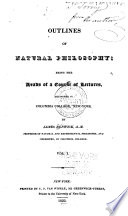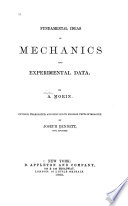 | 1822 - 524 pages
...point in a direction directly contrary to its true one. POISSON, § II. 37. The resultant of two forces is represented in magnitude and direction by the diagonal of a parallelogram whose sides represent the magnitude and direction of these two forces* POISSON, Additions. POISSON,... | |
 | James Renwick - Physics - 1822 - 476 pages
...point in a direction directly contrary to its true one. POISSON, § II. 37. The resultant of two forces is represented in magnitude and direction by the diagonal of a parallelogram whose sides represent the magnitude and direction of these two forces. PoisSON, Additions. POISSON,... | |
 | Mary Somerville - Astronomy - 1831 - 710 pages
...in a contrary direction, will keep the component forces in equilibrio. 27. Thus the resulting force is represented in magnitude and direction by the diagonal of a parallelogram, whose sides are mA, mB the partial ones. 28. Since the diagonal cm, fig. 6, is f'9- *>• the resultant... | |
 | Alexander Jamieson - Mechanics - 1845 - 572 pages
...resultant or equivalent of any three given forces, situated in the same plane, and concurring in one point, is represented in magnitude and direction by the diagonal of a parallelogram, constructed on the lines which represent the magnitude and direction of one of the forces, and the... | |
 | Olinthus Gilbert Gregory - 1848 - 572 pages
...point keep it in equilibrium, they must all act in the same plane ; and any one of those pressures is represented in magnitude and direction by the diagonal of a parallelogram, whose sides represent the other two pressures in magnitude and direction. 3. If any four pressures... | |
 | William Holms Chambers Bartlett - Mechanics - 1850 - 662 pages
...parallelogram a point; of forces, viz. : the resultant of any two forces applied to the same point, is represented, in magnitude and direction, by the diagonal of a parallelogram, constructed upon the lines which represent, in intensiiy and direction, the two forces. It must not... | |
 | William Holms Chambers Bartlett - Astronomy - 1850 - 640 pages
...denomination of parallelogram of forces, viz.: the resultant of any two forces applied to the same point, is represented, in magnitude and direction, by the diagonal of a parallelogram, constructed upon the lines which represent, in intensity and direction, the two forces. It must not... | |
 | Morin (M., Arthur Jules) - Mechanics - 1860 - 476 pages
...directions, the path really described in virtue of these two motions, and called the resultant path, is represented in magnitude and direction by the diagonal of a parallelogram constructed upon the two paths simultaneously described, and its motion in this direction is uniform... | |
 | Alfred Daniell - Physics - 1884 - 686 pages
...a single particle produce the same result as would be produced if a single force were acting on it, represented in magnitude and direction by the diagonal of a parallelogram of which the two single forces are represented in the same respects by the adjacent sides. This is the proposition... | |
 | Heinrich Hertz - Mechanics, Analytic - 1899 - 316 pages
...lines. In particular, two forces acting at the same point can be combined into a single force, which is represented in magnitude and direction by the diagonal of a parallelogram whose sides represent these forces in magnitude and direction (Parallelogram of Forces). 479. Corollary... | |
| |